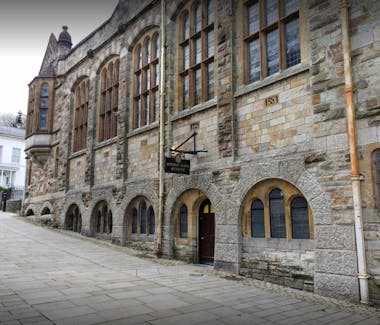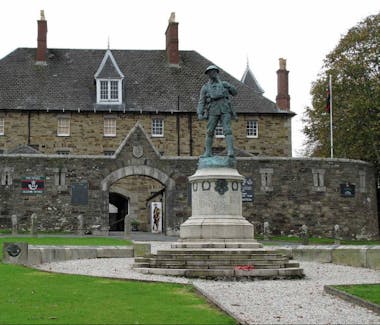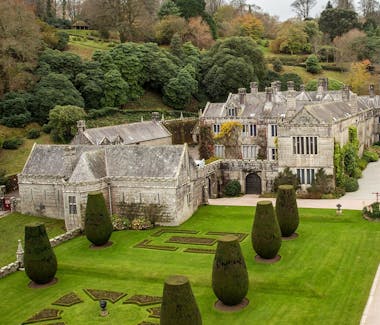Nearby places of interest
List of attractions

Berrycoombe Rd, Bodmin PL31 2NR
Bodmin Jail
Bodmin Jail is an historic former prison situated in Bodmin, on the edge of Bodmin Moor in Cornwall. Built in 1779 and closed in 1927, the large range of buildings is now largely in ruins, although parts of the prison have been turned into a tourist attraction. Originally built by King George III's command in 1779, today’s jail was built with the "help" of prisoners who were forced to bring 20,000 tons of granite from Bodmin’s Cuckoo Quarry. During the First World War the Jail held state papers and the Doomsday book — the Crown Jewels have also been given safe haven here as well.
Visitors can wander through the depths of the Jail, over six levels, and browse a series of exhibits depicting penal life in Victorian Cornwall. Those who visit the cold dank cells and look up at the thin rays of light filtering through a small barred window will hardly be able to imagine being sentenced to even a week in such desolation — a very lonely life with the certain knowledge that each day would bring more of the same cold, hunger and hard labour on the treadmill as a civil prisoner, or “cannon ball” catch for naval prisoners; designed to keep the latter fit for battle on their release.
Those of an especially macabre disposition may wish to visit the Execution Shed, a fully restored 15'-deep Victorian hanging pit, the only hanging pit in the UK and the site of the last man executed in Cornwall.
Visitors are invitied to appreciate the building’s unique design, architecture, and engineering, from the inspired heating and cooling systems constructed to keep the Jail environment comfortable to the striking carved wood panelling and period features of the Old Chapel; now housing the Governor's Hall restaurant.

2 Mount Folly, Bodmin PL31 2DB
Bodmin Town Museum
Bodmin Town Museum is truly a gem. A "boutique museum" in the finest sense of the word, this is one place that no visitor to Bodmin (and no Bodmin resident !) should miss. In only three rooms, the history of Bodmin is thoroughly explained, and friendly volunteers are on hand to answer any question the visitor might have. Sadly closed until 15th April 2019, as tourist numbers in low season are not sufficient to justify it opening 365 days a year.

The Keep, Bodmin, Cornwall PL31 1EG
Cornwall Regimental Museum
Cornwall's Regimental Museum museum is housed in The Keep, one of Bodmin’s most important historic buildings which dates from 1859. The Keep became the Duke of Cornwall’s Light Infantry headquarters in the 1880s and was a depot for weapons and munitions. The site gradually expanded and by the late 19th century there were stores, cells and living quarters for 400 or more officers, soldiers and married soldiers’ families.
In the First World War the Bodmin barracks saw more than 2000 soldiers set up camp as men from all over the country came to get three to six months of training before being sent into battle. The First World War Memorial Monument in front of the Keep, which was unveiled by the Prince of Wales in 1924, reminds us of the battles in which the Regiment fought. The war memorial is by well-known sculptor L S Merrifield. The soldier was modelled on William Harvey Triggs, who also modelled for the Newlyn School artist Stanhope Forbes.
During the early part of the Second World War, the Barracks continued to be used by the Regiment, and in May 1944 USA forces occupied the Keep for training for an invasion of Europe at Omaha Beach in Normandy, where a bloody battle was fought.
The Cold War saw the need for greater numbers of interpreters and intelligence officers, and this led to the establishment of a ‘Foreign Language School’ at Bodmin Barracks in 1951. The Joint Services School for Linguists (JSSL) was founded by the British armed services to provide mainly Russian language training to specially selected conscripts undergoing National Service. These included young men such as Alan Bennett, Michael Frayn and Dennis Potter. The school closed with the ending of conscription in 1960. The Keep closed as an operational depot in 1962. In the years that followed, the huge barracks site was gradually sold off for redevelopment, with The Keep being the only building retained by the MOD. It housed the museum, the County Regimental Office and a recruiting office.
Today, the Keep is the only Ministry of Defence building that remains on the old Bodmin barracks site. The museum is run by a charitable trust which aims to preserve and share the heritage of the Duke of Cornwall’s Light Infantry with as wide an audience as possible. The current regiment is The Rifles, which was formed in February 2007 by the amalgamation of the Devon and Dorset Light Infantry, the Royal Green Jackets, the Light Infantry and the Royal Gloucester, Berkshire and Wiltshire Light Infantry into a huge single regiment, the largest in the army.
Each of the 12,000 items in the Museum collection has its own story to tell. Stories about the battles that have been fought, weapons that were used or personal letters that were written on the battlefield. This former headquarters of the Duke of Cornwall’s Light Infantry houses more than three hundred years of military history, a library and conference and exhibition rooms.

Treffry Lane, Bodmin PL30 5AD, UK
Lanhydrock House
Lanhydrock House (not to be confused with Lanhydrock Golf Club) is a magnificent late Victorian country house with garden and glorious wooded estate.
When Thomas Charles refashioned Lanhydrock after a fire in 1881, he wanted to create 'an unpretentious family home'. While his idea of everyday comfort might be different from today's, there is no doubting the family is at the very heart of this house. There's a whole suite of rooms dedicated to the children, family photographs throughout and the morning room was even used by the children as a performance space for annual plays and theatricals. After the 1881 fire, Thomas Charles filled Lanhydrock with the latest technology. Look out for state-of-the-art ovens and warming cupboards in the kitchen and dining areas, central heating systems and fire hydrants.
